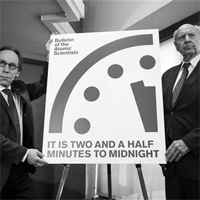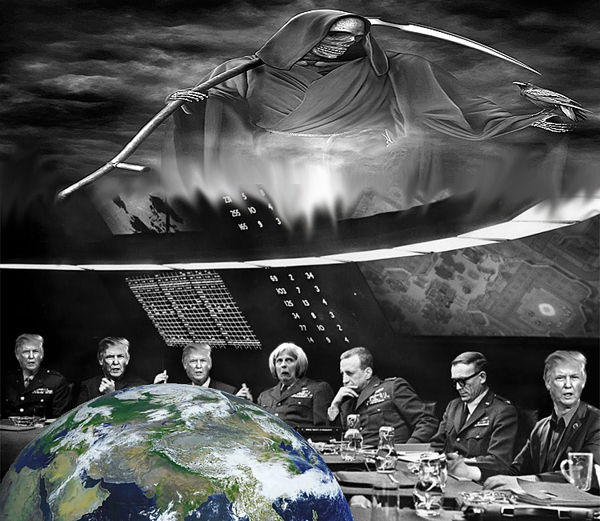 |
 |
|
The Doomsday Clock is ticking and the minute hand has moved the closest to midnight that it has ever been since the days of Thatcher and Regan.
They wanted a graphic to use that represented an urgent call to action across the globe with regard to the peril that the planet is in due to the threats of nuclear war and more latterly includes not only the arms race, and proliferation of nuclear weapons; but global warming. The face of a clock, and the countdown to midnight seemed to perfectly illustrate the urgency of the situation. The Doomsday Clock, as it came to be called, has served as a globally recognized arbiter of the planet’s health and safety ever since that first edition of what is now a glossy magazine type bulletin, and is issued annually by the Science and Security Board of nuclear scientists, in consultation with its Board of Sponsors, which includes 15 Nobel laureates. Founded in 1945 by University of Chicago scientists who had helped develop the first atomic weapons in the Manhattan Project, the Bulletin of the Atomic Scientists has been issued annually ever since it's first publication in 1947. The decision to move (or to leave in place) the minute hand of the Doomsday Clock is made every year by the Bulletin’s Science and Security Board in consultation with its Board of Sponsors, which includes 15 Nobel laureates. The Clock has become a universally recognized indicator of the world’s vulnerability to catastrophe from nuclear weapons, climate change, and new technologies emerging in other domains. Doomsday Clock Statement 2017 Nuclear weapons and climate change are precisely the sort of complex existential threats that cannot be properly managed without access to and reliance on expert knowledge. • US and Russian leaders return to the negotiating table to seek further reductions in nuclear arms and to limit nuclear modernization programs that threaten to create a new nuclear arms race. The world can be more secure with much, much smaller nuclear arsenals than now exist— if political leaders are truly interested in protecting their citizens from harm. • The United States and Russia reduce the alert levels of their nuclear weapons and use existing crisis stability mechanisms to avoid inadvertent escalation of conflict. Provocative military exercises increase the possibilities for accidental war and should cease. • Governments around the world sharply reduce their countries’ greenhouse gas emissions and fulfill the Paris Accord promise of keeping warming to 2 degrees Celsius above preindustrial levels, or less. This temperature target is consistent with consensus views on climate science and is eminently achievable and economically viable, provided that poorer countries are given the support they need to make the post-carbon transition.
• The Trump administration acknowledge climate change as a science-backed reality and redouble US efforts to limit carbon dioxide emissions and support carbonfree energy sources, including, when economically reasonable and safe over the long term, nuclear energy. It is well past time to move beyond arguments over the reality of climate change and on to solutions, including fiscal measures—such as carbon markets and carbon taxes or fees—that encourage efficiency and put a price on carbon emissions. • The United States, China, Russia, and other concerned nations engage with North Korea to reduce nuclear risks. Neighbors in Asia face the most urgent threat, but as North Korea improves its nuclear and missile arsenals, the threat will rapidly become global. As we said last year and repeat here: Now is not the time to tighten North Korea’s isolation but to engage seriously in dialogue. • Leaders of countries with commercial nuclear power programs deal responsibly with safety issues and with the commercial nuclear waste problem. Top experts disagree on whether an expansion of nuclear-powered electricity generation can become a major component of the effort to limit climate change. Regardless of the trajectory of the global nuclear industry, there will be a continuing need for safe and secure interim and permanent nuclear waste storage facilities and for ever-safer nuclear power plants. • The countries of the world collaborate on creating institutions specifically assigned to explore and address potentially malign or catastrophic misuses of new technologies. Scientific advance can provide society with great benefits. But as events surrounding the recent US presidential election show, the potential for misuse of potent new technologies is real. Governmental, scientific, and business leaders need to take appropriate steps to address possibly devastating consequences of these technologies. A printable PDF of this statement, complete with the executive director’s statement and Science and Security Board biographies, is available here and from the E-Library Database Source: Bulletin Of Atomic Scientists / C Ingram
|
 The Doomsday Clock originated as the front page graphic of the first edition of the Bulletin of the Atomic Scientists issued in 1947 by scientists who had created the first atomic weapons.
The Doomsday Clock originated as the front page graphic of the first edition of the Bulletin of the Atomic Scientists issued in 1947 by scientists who had created the first atomic weapons. 